Comprehensive Analysis: Advanced BPMN/BPM Lifecycle Scenario
VerifiedAdded on 2023/03/21
|12
|872
|48
Project
AI Summary
This project presents a detailed analysis of an advanced BPMN/BPM lifecycle scenario, focusing on process improvement. It includes 'as-is' and 'to-be' process diagrams, value chain analysis, and a fishbone diagram to identify issues. The analysis covers cycle time calculations, workload assessments, and proposals for optimizing resource utilization. Key issues such as inexperienced staff and delayed repairs are addressed with qualitative and quantitative impact assessments. The document also provides a 'to-be' model with recommendations for process improvements and references relevant literature. Desklib offers students access to this and many other solved assignments and past papers.
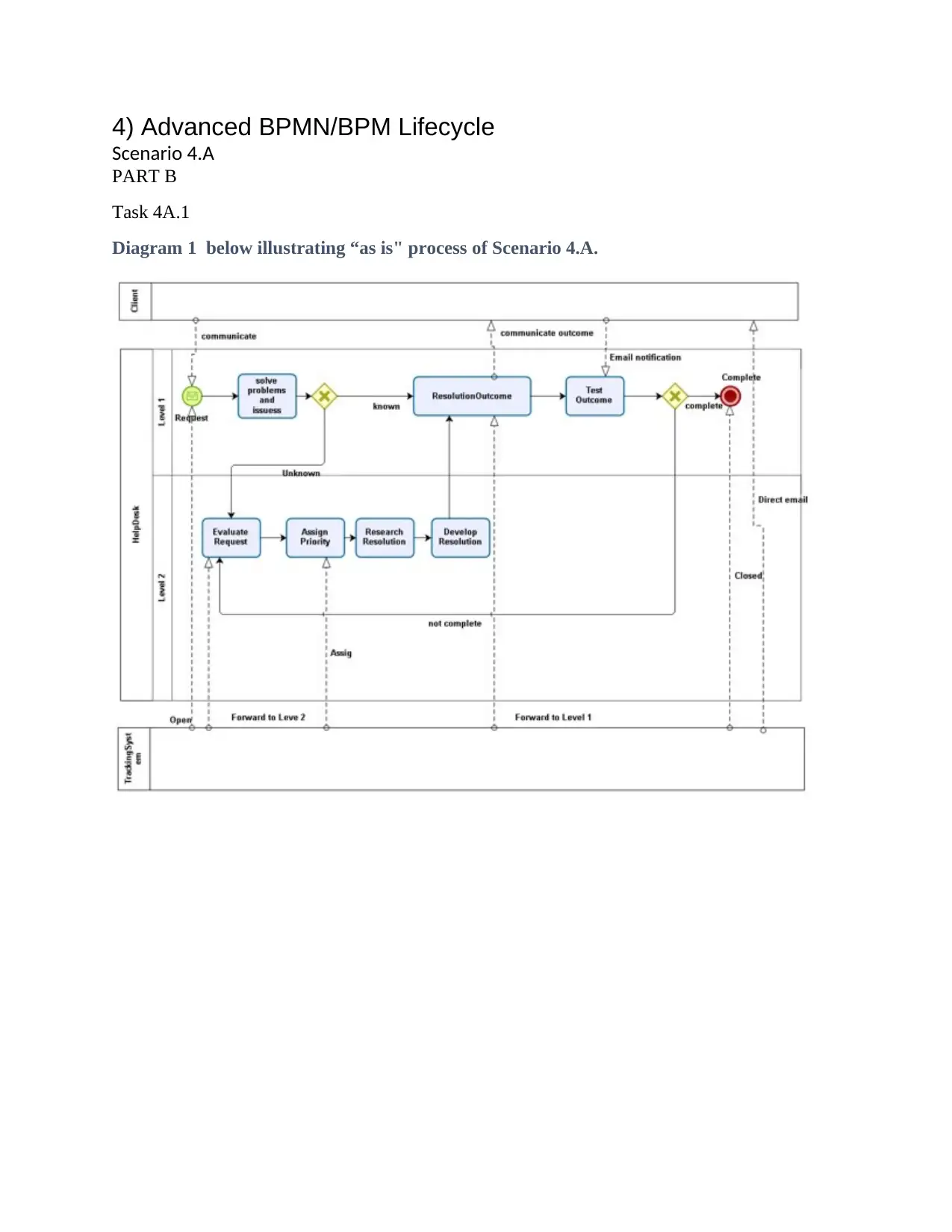
4) Advanced BPMN/BPM Lifecycle
Scenario 4.A
PART B
Task 4A.1
Diagram 1 below illustrating “as is" process of Scenario 4.A.
Scenario 4.A
PART B
Task 4A.1
Diagram 1 below illustrating “as is" process of Scenario 4.A.
Paraphrase This Document
Need a fresh take? Get an instant paraphrase of this document with our AI Paraphraser
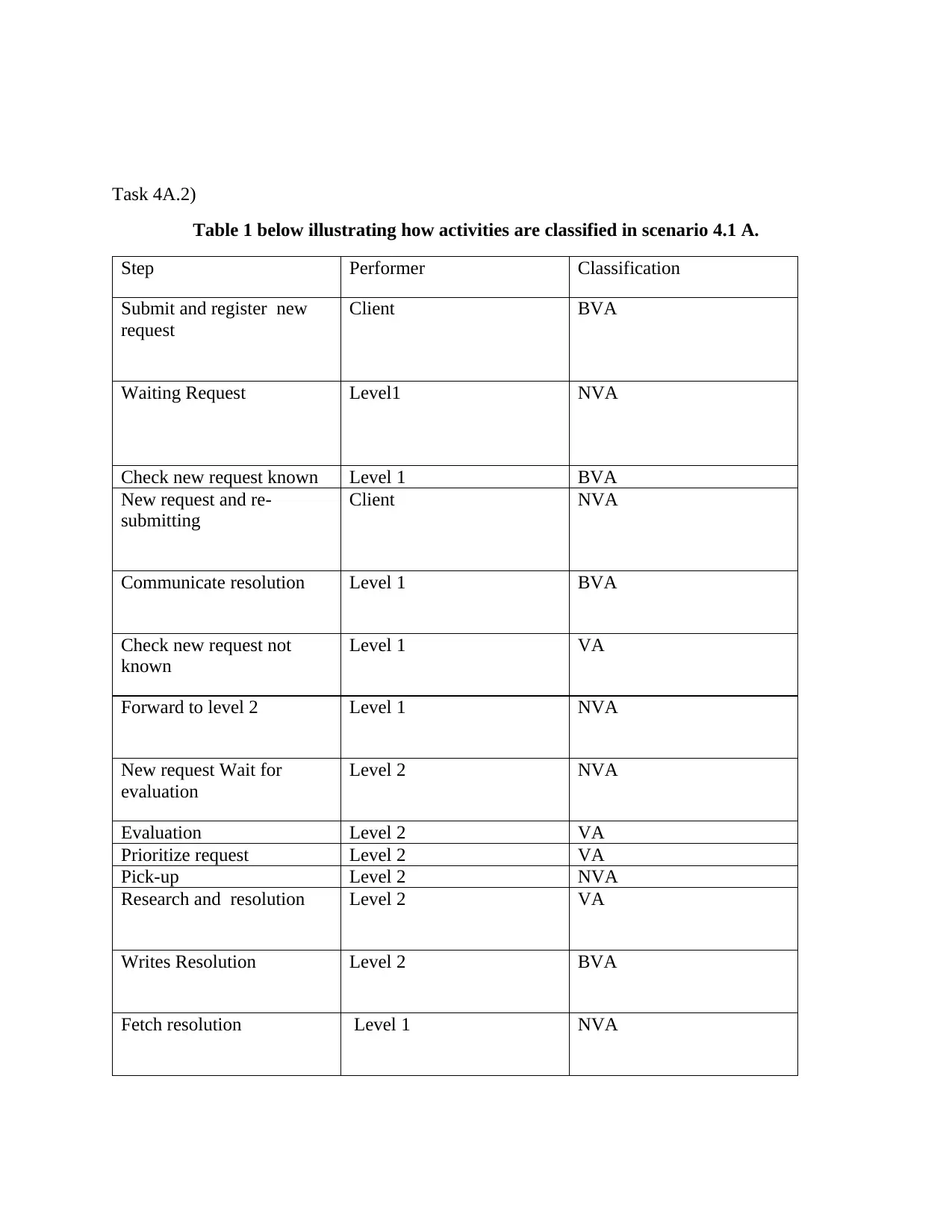
Task 4A.2)
Table 1 below illustrating how activities are classified in scenario 4.1 A.
Step Performer Classification
Submit and register new
request
Client BVA
Waiting Request Level1 NVA
Check new request known Level 1 BVA
New request and re-
submitting
Client NVA
Communicate resolution Level 1 BVA
Check new request not
known
Level 1 VA
Forward to level 2 Level 1 NVA
New request Wait for
evaluation
Level 2 NVA
Evaluation Level 2 VA
Prioritize request Level 2 VA
Pick-up Level 2 NVA
Research and resolution Level 2 VA
Writes Resolution Level 2 BVA
Fetch resolution Level 1 NVA
Table 1 below illustrating how activities are classified in scenario 4.1 A.
Step Performer Classification
Submit and register new
request
Client BVA
Waiting Request Level1 NVA
Check new request known Level 1 BVA
New request and re-
submitting
Client NVA
Communicate resolution Level 1 BVA
Check new request not
known
Level 1 VA
Forward to level 2 Level 1 NVA
New request Wait for
evaluation
Level 2 NVA
Evaluation Level 2 VA
Prioritize request Level 2 VA
Pick-up Level 2 NVA
Research and resolution Level 2 VA
Writes Resolution Level 2 BVA
Fetch resolution Level 1 NVA
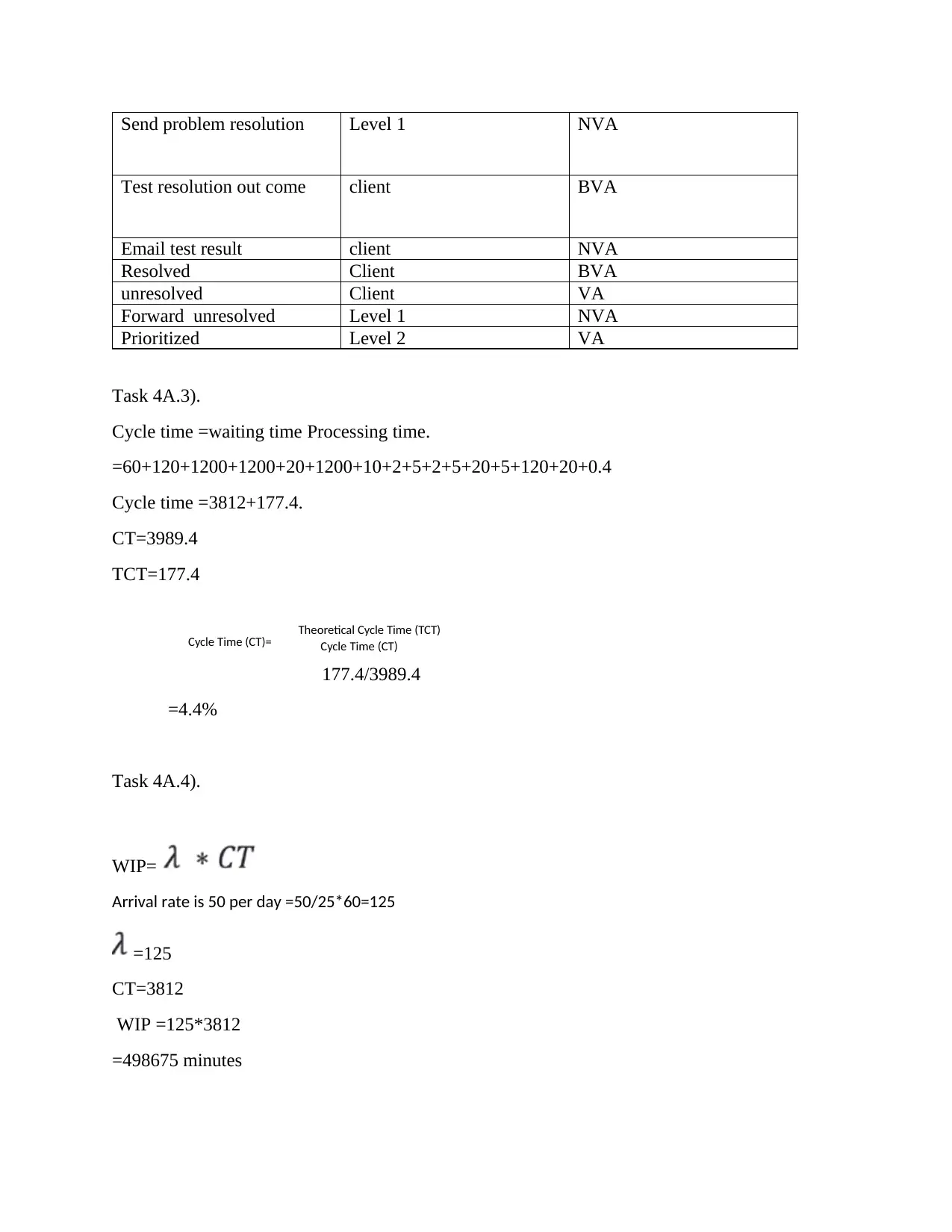
Send problem resolution Level 1 NVA
Test resolution out come client BVA
Email test result client NVA
Resolved Client BVA
unresolved Client VA
Forward unresolved Level 1 NVA
Prioritized Level 2 VA
Task 4A.3).
Cycle time =waiting time Processing time.
=60+120+1200+1200+20+1200+10+2+5+2+5+20+5+120+20+0.4
Cycle time =3812+177.4.
CT=3989.4
TCT=177.4
Cycle Time (CT)=
177.4/3989.4
=4.4%
Task 4A.4).
WIP=
Arrival rate is 50 per day =50/25*60=125
=125
CT=3812
WIP =125*3812
=498675 minutes
Theoretical Cycle Time (TCT)
Cycle Time (CT)
Test resolution out come client BVA
Email test result client NVA
Resolved Client BVA
unresolved Client VA
Forward unresolved Level 1 NVA
Prioritized Level 2 VA
Task 4A.3).
Cycle time =waiting time Processing time.
=60+120+1200+1200+20+1200+10+2+5+2+5+20+5+120+20+0.4
Cycle time =3812+177.4.
CT=3989.4
TCT=177.4
Cycle Time (CT)=
177.4/3989.4
=4.4%
Task 4A.4).
WIP=
Arrival rate is 50 per day =50/25*60=125
=125
CT=3812
WIP =125*3812
=498675 minutes
Theoretical Cycle Time (TCT)
Cycle Time (CT)
⊘ This is a preview!⊘
Do you want full access?
Subscribe today to unlock all pages.

Trusted by 1+ million students worldwide
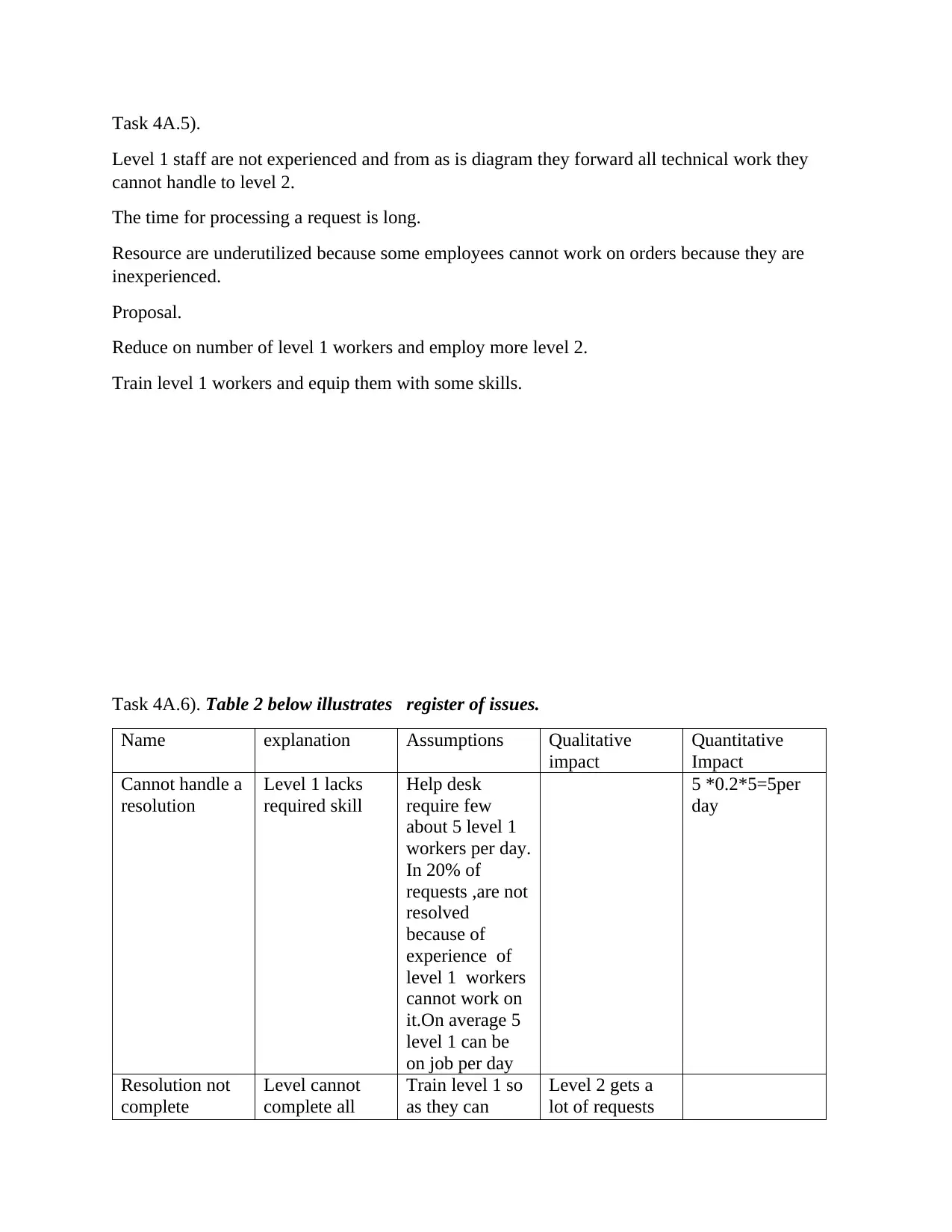
Task 4A.5).
Level 1 staff are not experienced and from as is diagram they forward all technical work they
cannot handle to level 2.
The time for processing a request is long.
Resource are underutilized because some employees cannot work on orders because they are
inexperienced.
Proposal.
Reduce on number of level 1 workers and employ more level 2.
Train level 1 workers and equip them with some skills.
Task 4A.6). Table 2 below illustrates register of issues.
Name explanation Assumptions Qualitative
impact
Quantitative
Impact
Cannot handle a
resolution
Level 1 lacks
required skill
Help desk
require few
about 5 level 1
workers per day.
In 20% of
requests ,are not
resolved
because of
experience of
level 1 workers
cannot work on
it.On average 5
level 1 can be
on job per day
5 *0.2*5=5per
day
Resolution not
complete
Level cannot
complete all
Train level 1 so
as they can
Level 2 gets a
lot of requests
Level 1 staff are not experienced and from as is diagram they forward all technical work they
cannot handle to level 2.
The time for processing a request is long.
Resource are underutilized because some employees cannot work on orders because they are
inexperienced.
Proposal.
Reduce on number of level 1 workers and employ more level 2.
Train level 1 workers and equip them with some skills.
Task 4A.6). Table 2 below illustrates register of issues.
Name explanation Assumptions Qualitative
impact
Quantitative
Impact
Cannot handle a
resolution
Level 1 lacks
required skill
Help desk
require few
about 5 level 1
workers per day.
In 20% of
requests ,are not
resolved
because of
experience of
level 1 workers
cannot work on
it.On average 5
level 1 can be
on job per day
5 *0.2*5=5per
day
Resolution not
complete
Level cannot
complete all
Train level 1 so
as they can
Level 2 gets a
lot of requests
Paraphrase This Document
Need a fresh take? Get an instant paraphrase of this document with our AI Paraphraser
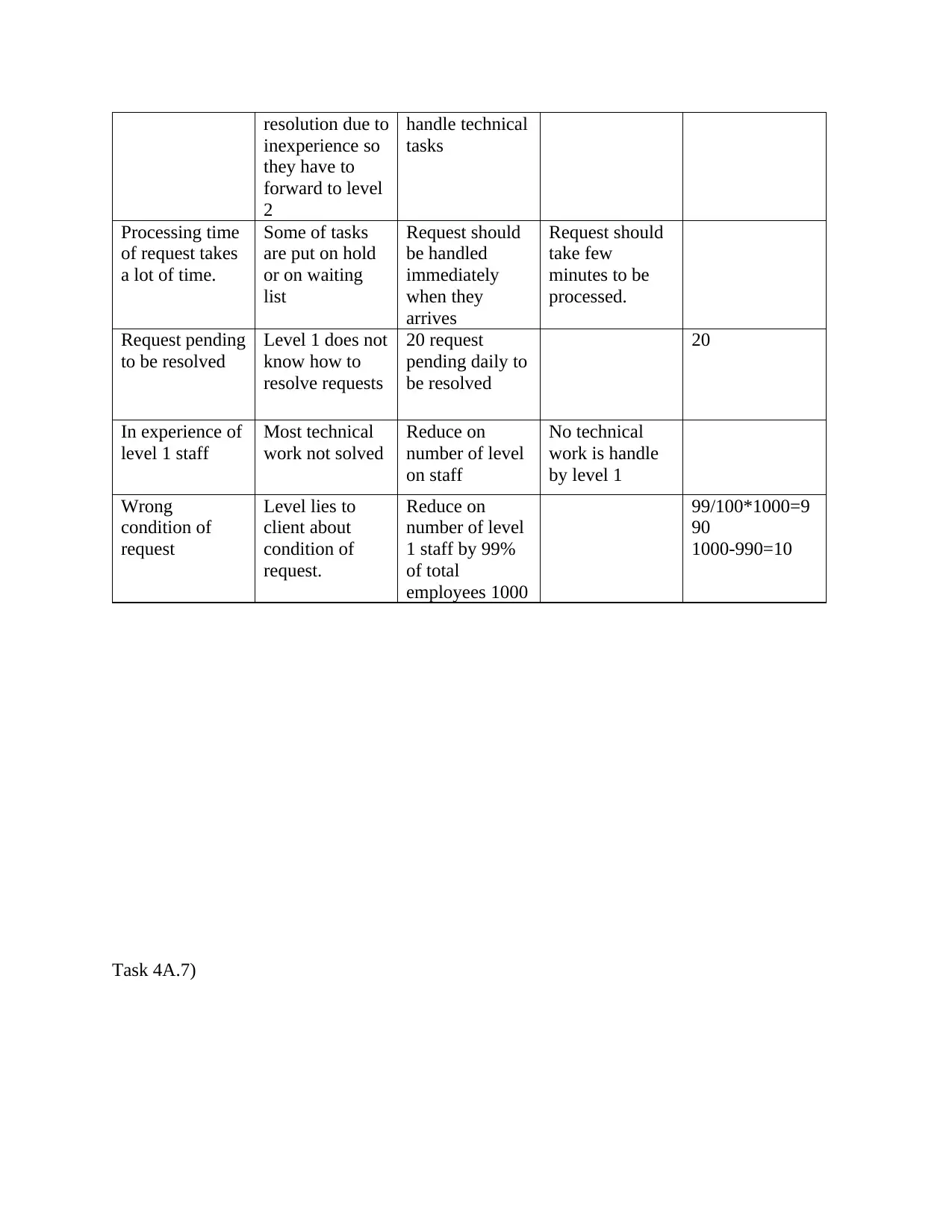
resolution due to
inexperience so
they have to
forward to level
2
handle technical
tasks
Processing time
of request takes
a lot of time.
Some of tasks
are put on hold
or on waiting
list
Request should
be handled
immediately
when they
arrives
Request should
take few
minutes to be
processed.
Request pending
to be resolved
Level 1 does not
know how to
resolve requests
20 request
pending daily to
be resolved
20
In experience of
level 1 staff
Most technical
work not solved
Reduce on
number of level
on staff
No technical
work is handle
by level 1
Wrong
condition of
request
Level lies to
client about
condition of
request.
Reduce on
number of level
1 staff by 99%
of total
employees 1000
99/100*1000=9
90
1000-990=10
Task 4A.7)
inexperience so
they have to
forward to level
2
handle technical
tasks
Processing time
of request takes
a lot of time.
Some of tasks
are put on hold
or on waiting
list
Request should
be handled
immediately
when they
arrives
Request should
take few
minutes to be
processed.
Request pending
to be resolved
Level 1 does not
know how to
resolve requests
20 request
pending daily to
be resolved
20
In experience of
level 1 staff
Most technical
work not solved
Reduce on
number of level
on staff
No technical
work is handle
by level 1
Wrong
condition of
request
Level lies to
client about
condition of
request.
Reduce on
number of level
1 staff by 99%
of total
employees 1000
99/100*1000=9
90
1000-990=10
Task 4A.7)
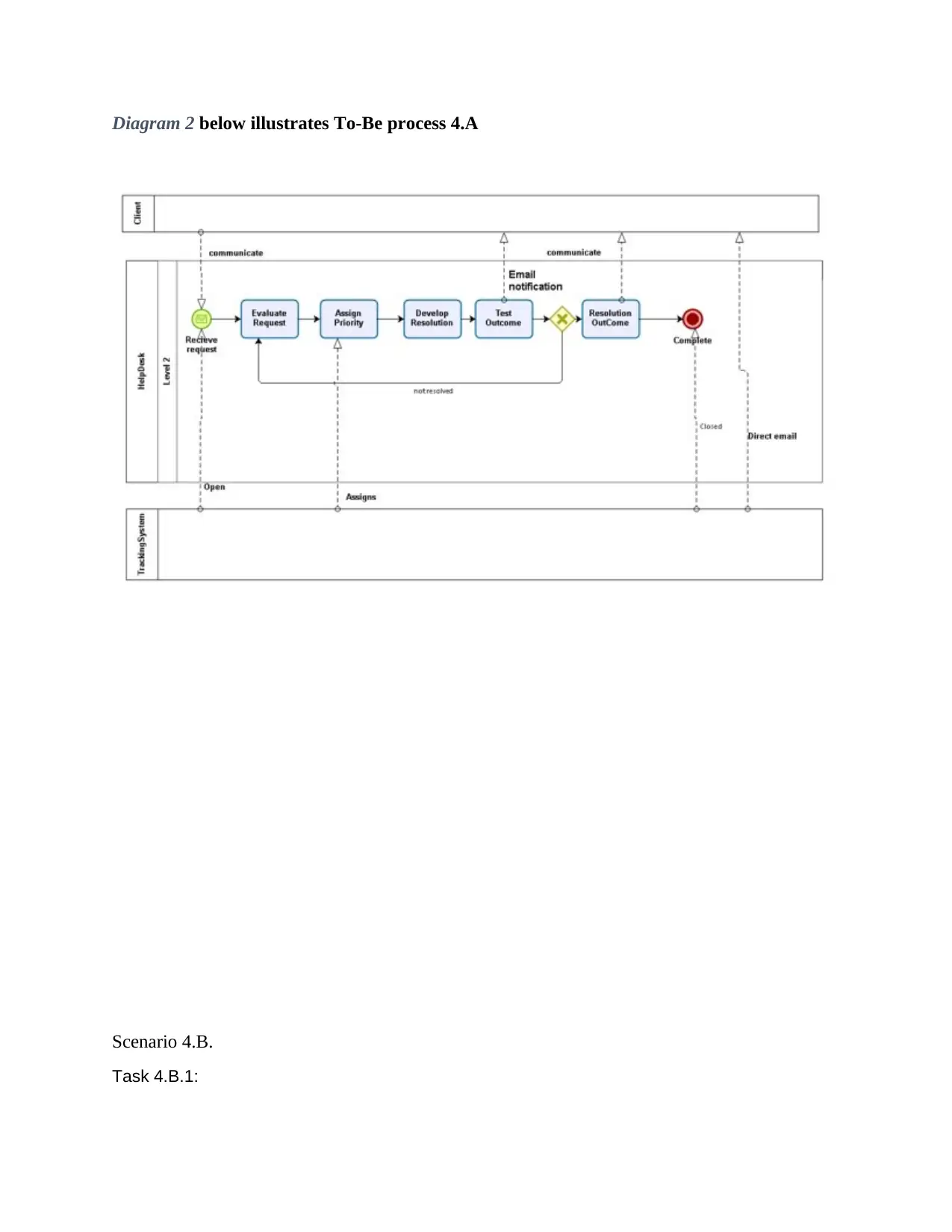
Diagram 2 below illustrates To-Be process 4.A
Scenario 4.B.
Task 4.B.1:
Scenario 4.B.
Task 4.B.1:
⊘ This is a preview!⊘
Do you want full access?
Subscribe today to unlock all pages.

Trusted by 1+ million students worldwide
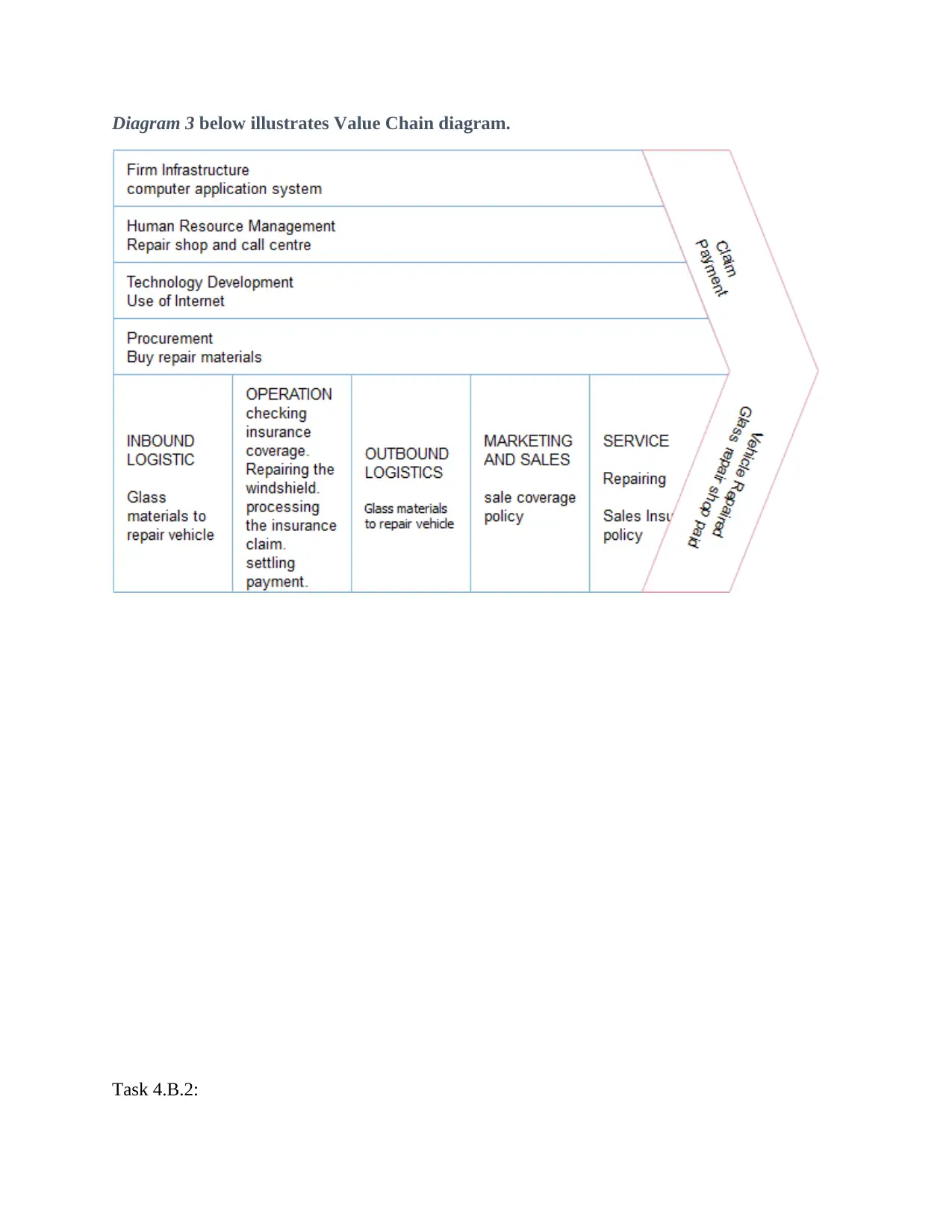
Diagram 3 below illustrates Value Chain diagram.
Task 4.B.2:
Task 4.B.2:
Paraphrase This Document
Need a fresh take? Get an instant paraphrase of this document with our AI Paraphraser
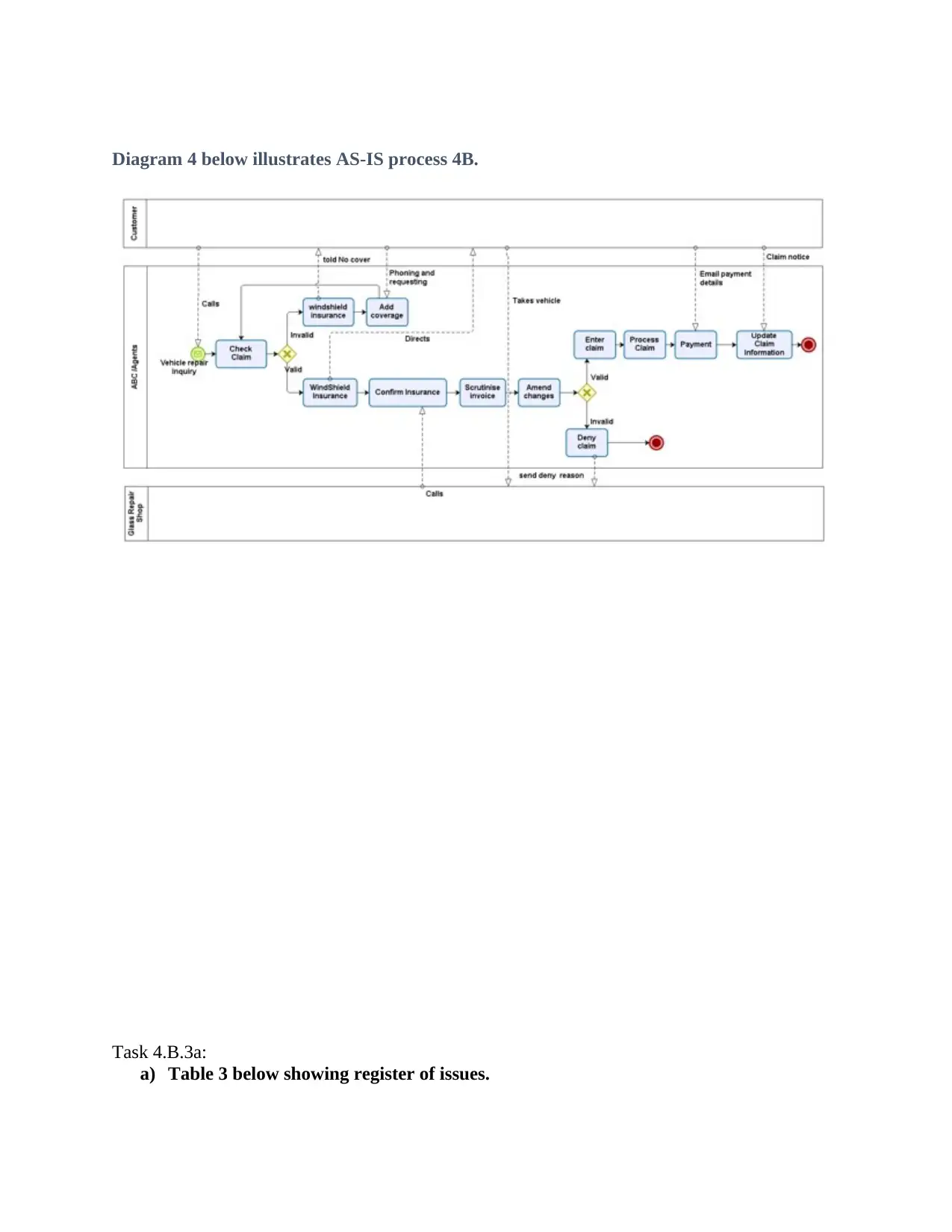
Diagram 4 below illustrates AS-IS process 4B.
Task 4.B.3a:
a) Table 3 below showing register of issues.
Task 4.B.3a:
a) Table 3 below showing register of issues.
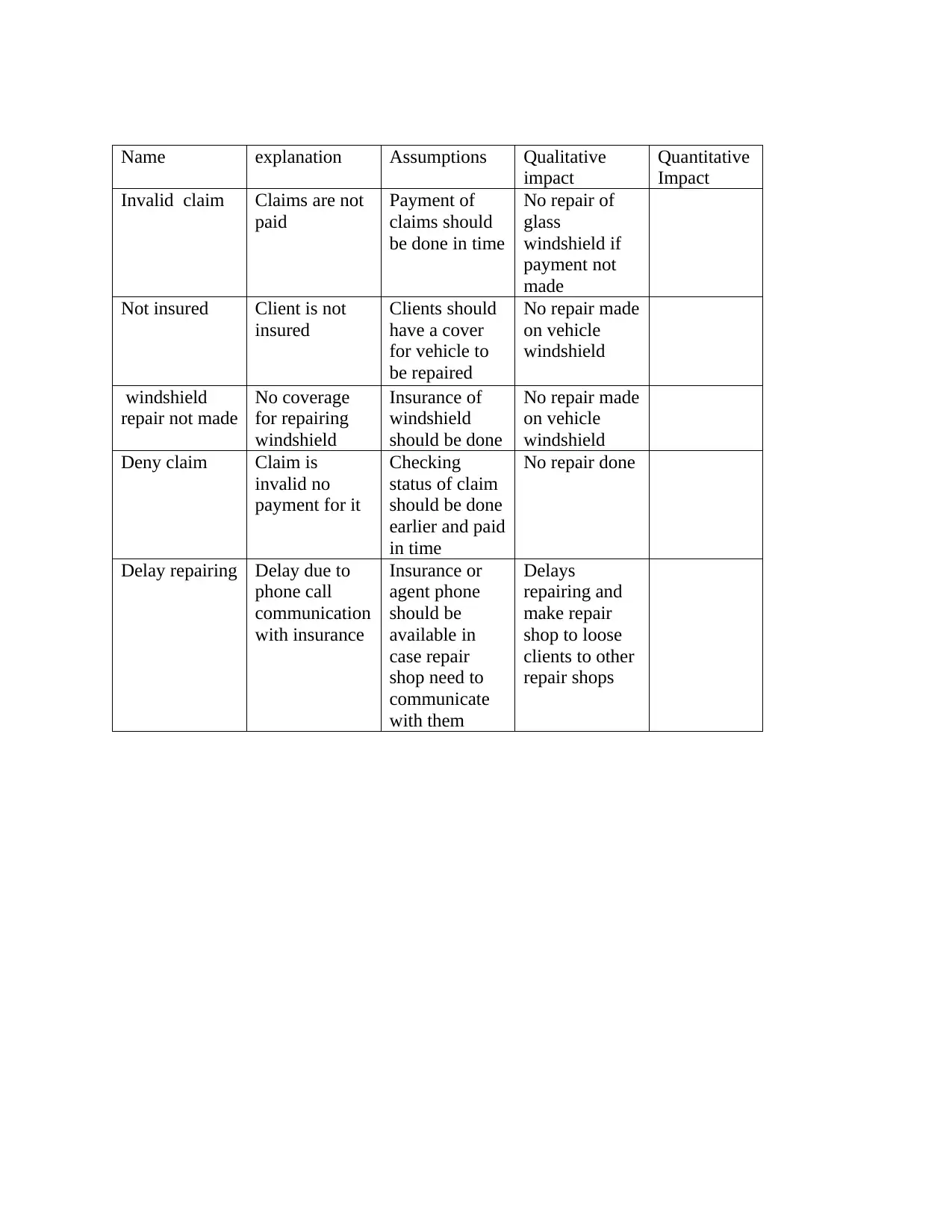
Name explanation Assumptions Qualitative
impact
Quantitative
Impact
Invalid claim Claims are not
paid
Payment of
claims should
be done in time
No repair of
glass
windshield if
payment not
made
Not insured Client is not
insured
Clients should
have a cover
for vehicle to
be repaired
No repair made
on vehicle
windshield
windshield
repair not made
No coverage
for repairing
windshield
Insurance of
windshield
should be done
No repair made
on vehicle
windshield
Deny claim Claim is
invalid no
payment for it
Checking
status of claim
should be done
earlier and paid
in time
No repair done
Delay repairing Delay due to
phone call
communication
with insurance
Insurance or
agent phone
should be
available in
case repair
shop need to
communicate
with them
Delays
repairing and
make repair
shop to loose
clients to other
repair shops
impact
Quantitative
Impact
Invalid claim Claims are not
paid
Payment of
claims should
be done in time
No repair of
glass
windshield if
payment not
made
Not insured Client is not
insured
Clients should
have a cover
for vehicle to
be repaired
No repair made
on vehicle
windshield
windshield
repair not made
No coverage
for repairing
windshield
Insurance of
windshield
should be done
No repair made
on vehicle
windshield
Deny claim Claim is
invalid no
payment for it
Checking
status of claim
should be done
earlier and paid
in time
No repair done
Delay repairing Delay due to
phone call
communication
with insurance
Insurance or
agent phone
should be
available in
case repair
shop need to
communicate
with them
Delays
repairing and
make repair
shop to loose
clients to other
repair shops
⊘ This is a preview!⊘
Do you want full access?
Subscribe today to unlock all pages.

Trusted by 1+ million students worldwide
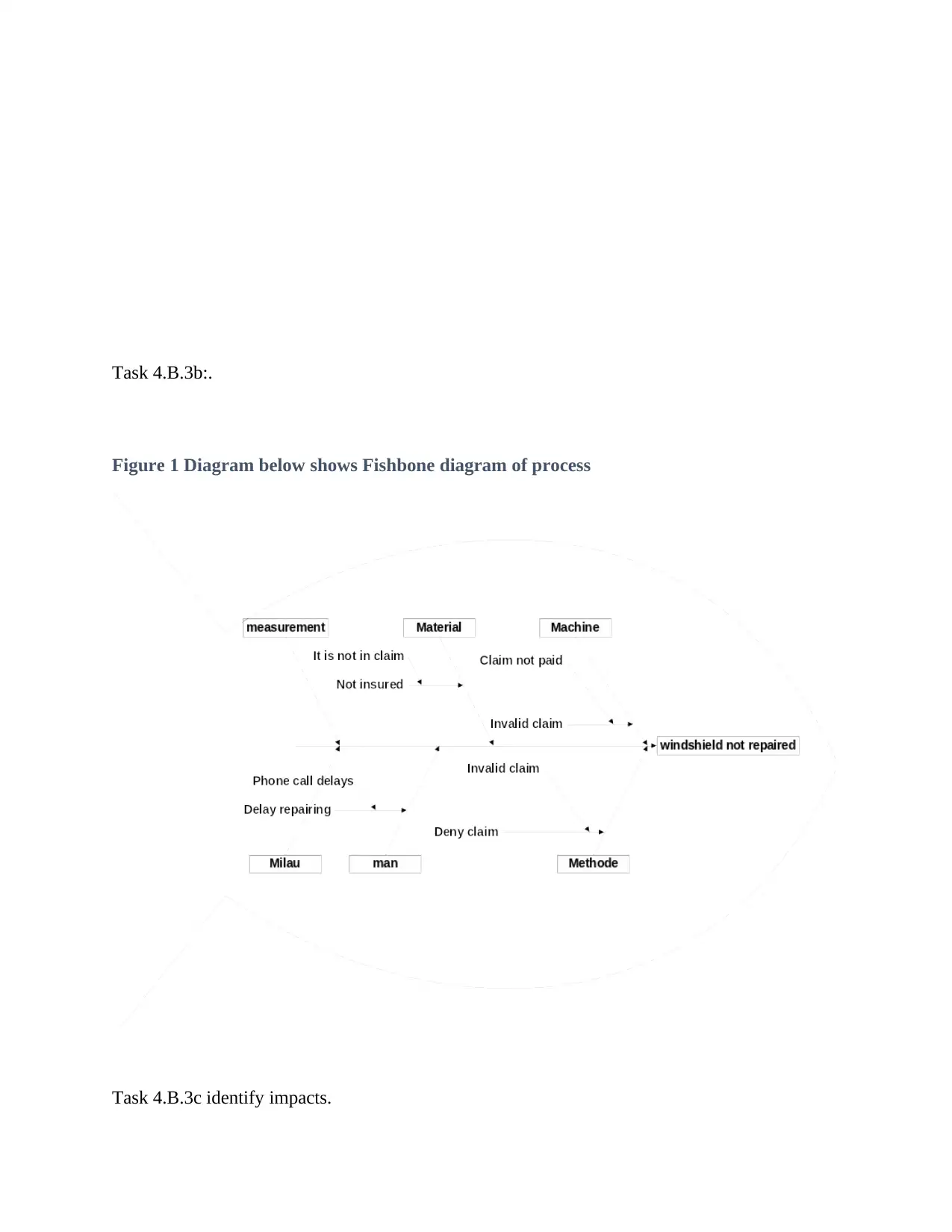
Task 4.B.3b:.
Figure 1 Diagram below shows Fishbone diagram of process
Task 4.B.3c identify impacts.
Figure 1 Diagram below shows Fishbone diagram of process
Task 4.B.3c identify impacts.
Paraphrase This Document
Need a fresh take? Get an instant paraphrase of this document with our AI Paraphraser
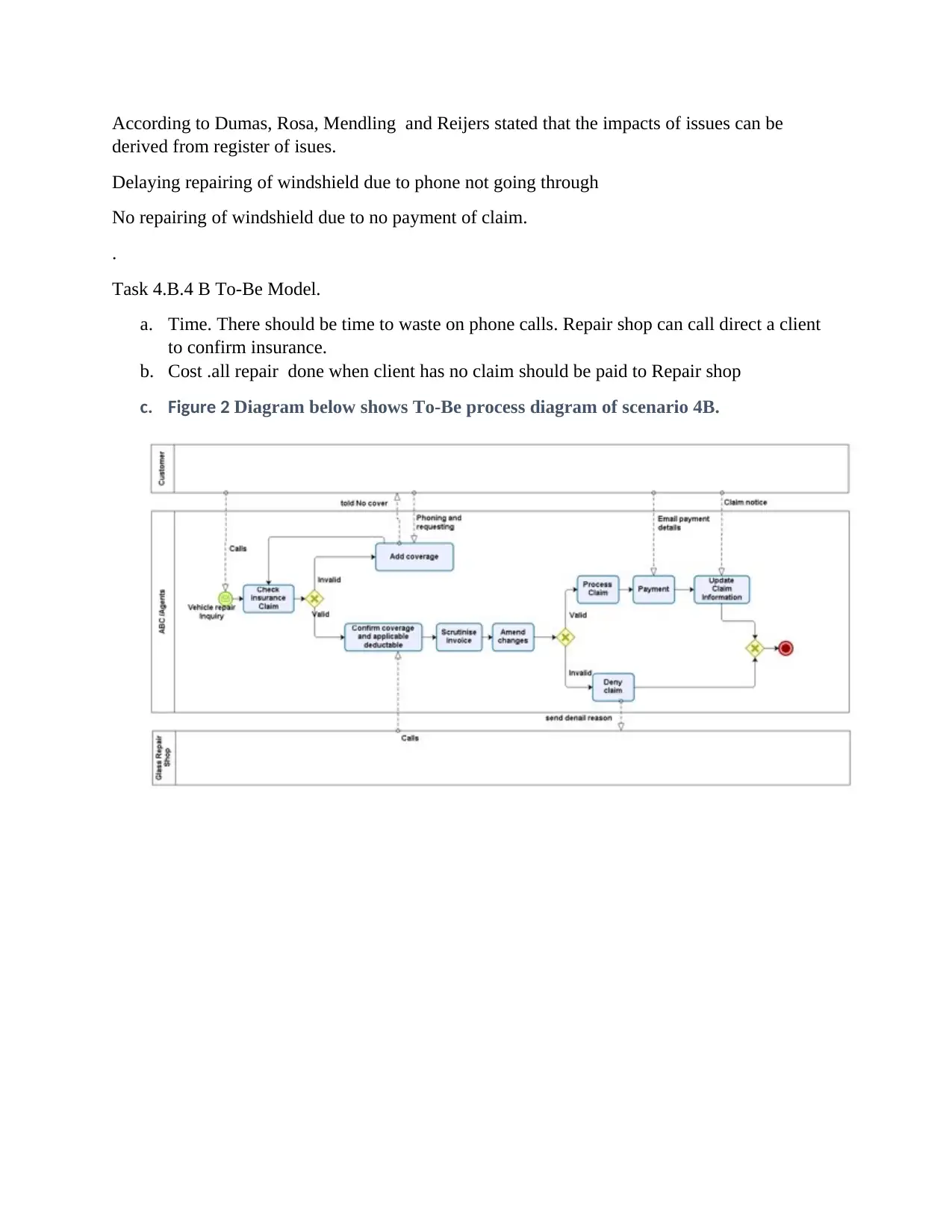
According to Dumas, Rosa, Mendling and Reijers stated that the impacts of issues can be
derived from register of isues.
Delaying repairing of windshield due to phone not going through
No repairing of windshield due to no payment of claim.
.
Task 4.B.4 B To-Be Model.
a. Time. There should be time to waste on phone calls. Repair shop can call direct a client
to confirm insurance.
b. Cost .all repair done when client has no claim should be paid to Repair shop
c. Figure 2 Diagram below shows To-Be process diagram of scenario 4B.
derived from register of isues.
Delaying repairing of windshield due to phone not going through
No repairing of windshield due to no payment of claim.
.
Task 4.B.4 B To-Be Model.
a. Time. There should be time to waste on phone calls. Repair shop can call direct a client
to confirm insurance.
b. Cost .all repair done when client has no claim should be paid to Repair shop
c. Figure 2 Diagram below shows To-Be process diagram of scenario 4B.

References.
Dumas, M, Rosa, M, Mendling, J and Reijers, A, H. (2016).Fundamentals of Business Process
Management (3rd Ed).New York, springer.
Dumas, M, Rosa, M, Mendling, J and Reijers, A, H. (2016).Fundamentals of Business Process
Management (3rd Ed).New York, springer.
⊘ This is a preview!⊘
Do you want full access?
Subscribe today to unlock all pages.

Trusted by 1+ million students worldwide
1 out of 12
Related Documents
Your All-in-One AI-Powered Toolkit for Academic Success.
+13062052269
info@desklib.com
Available 24*7 on WhatsApp / Email
![[object Object]](/_next/static/media/star-bottom.7253800d.svg)
Unlock your academic potential
Copyright © 2020–2025 A2Z Services. All Rights Reserved. Developed and managed by ZUCOL.




